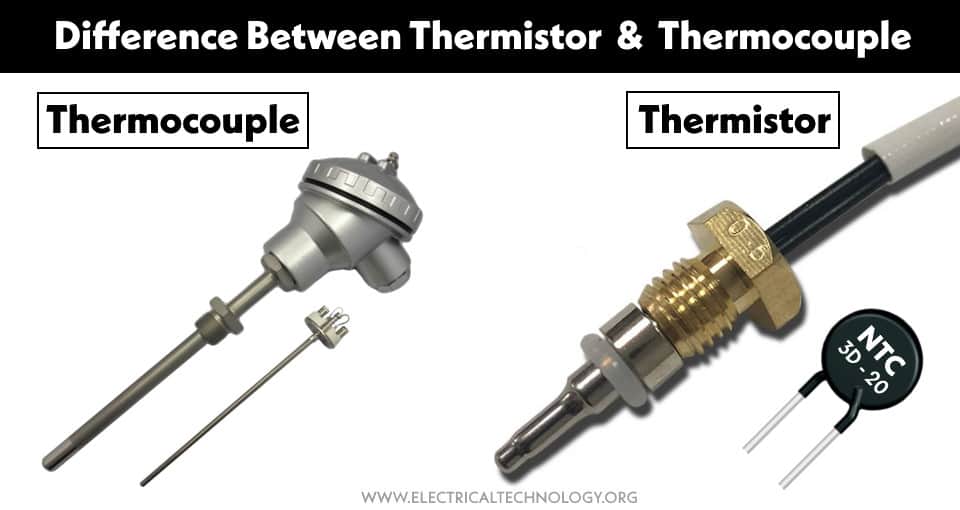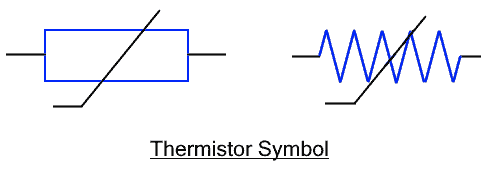Difference Between Thermistor and Thermocouple
Difference between Thermistor and Thermocouple
Temperature affects the operation of any electrical or electronic component or a device. It is necessary to monitor and maintain the temperature. Thermistors and thermocouples are some of the temperature sensing devices used for measuring temperature.
Both thermistor and thermocouple can measure temperature efficiently but the factor that differentiates between them is how they sense temperature. There are several such differences between thermistor and thermocouple explained in this article.
Related Post: Difference between RTD and Thermocouple
Before going into the list of differences between thermistor and thermocouple, let’s discuss their basics first.
What is Thermistor?
Thermistor is a type of variable resistor whose resistance varies with change in temperature. Every electrical component’s resistance varies with temperature but a thermistor resistance changes very significantly and it can respond to very small temperature changes.
A thermistor is classified into PTC (positive thermal coefficient) and NTC (negative thermal coefficient) thermistor. A PTC thermistor resistance increases with an increase in temperature while an NTC thermistor’s resistance decreases with an increase in temperature.
The resistance varies non-linearly with changes in temperature. Therefore, the temperature range is limited to -150 and 200 C°. However, it is very sensitive and can sense very small temperature variations. Some linear PTC thermistors are available but they have very limited range and sensitivity.
Thermistors are not expensive but they do require external circuitry which makes them expensive as compared to thermocouples. The non-linear response also makes it complicated to translate the resistance accurately into temperature.
Main Features of Thermistor
- A thermistor is a thermal resistor whose resistance varies with temperature.
- Its sensing parameter is resistance.
- It is a passive sensor that requires an extra power source to convert resistance into an electrical signal.
- It has a non-linear relationship between resistance and temperature.
- The self-heating due to its own resistance can inflict error in the reading.
- It has very high sensitivity and it can measure small temperature changes.
- It has a limited temperature range between -150° to 200°
- It has a quick response of 0.2 – 10s.
- It has low cost and is more efficient. But overall cost is higher due to the requirement of external power source.
- It is available in every shape and size.
- The variable resistance feature is used for overcurrent protection.
- It is also used for safe motor starting.
- Due to the small size of the bead thermistor, it can measure the temperature of a small point.
- It is used in domestic appliances.
Related Posts:
What is Thermocouple?
Thermocouple is a device used for measuring temperature. It is made of two different metals whose one end is joined together at a junction called hot junction while the other end remains separated called cold junction or reference junction. It measures the temperature at a hot junction with respect to the reference junction.
When heat is applied to the hot junction, a thermoelectric potential is induced between the wires at the reference junction due to the temperature difference between the metal. The voltage generated between its two terminals is proportional to the difference in temperature between its junctions. The voltage is translated into temperature using a temperature scale.
Thermocouple is an active sensor that does not require an extra power source to operate. It has a wide range of temperature measurements of up to 1200°C. However, they are less accurate as compared to thermistors. It has a simple design but it requires special extension wires to connect to other systems.
Thermocouple generates a very low voltage that is roughly about 5 μVolts/C°.
Main Feature of Thermocouple
- A thermocouple is made of two different metals that induce voltage with a change in temperature.
- Its sensing parameter is voltage.
- It is an active sensor as it does not require an extra power source.
- It has a linear response i.e. its output voltage varies linearly with change in temperature.
- Due to linear response, it is easier to translate voltage into temperature.
- It operates at very high temperatures around -200 – 1200 °C.
- It has a quick response time of 0.12 – 10s.
- It is cost-efficient as it does not require any power source.
Related Post: Thermocouple – Types, Construction, Working and Applications
Differences between Thermistor and Thermocouple
| Thermistor | Thermocouple |
| It is a thermal resistance whose resistance varies with changes in temperature. | It is a device that generates a voltage based on the temperature difference between its junctions. |
| It is made of semiconductor material including manganese, cobalt and nickel. | It is made of two different metals. |
| Its sensing parameter is resistance | Its sensing parameter is voltage. |
| It is a passive sensor. | It is an active sensor. |
| The self-heating effect can generate errors in reading. | It has a more accurate reading. |
| It has a non-linear response. | It has mostly linear responses. |
| It is extremely sensitive. | It is less sensitive. |
| it has a limited temperature range between -150 – 200 °C. | It operates at a wide range of temperatures ranging between -200 – 1200 °C. |
| It has a quick response time of 0.2 – 10s. | It has a quicker response time of 0.12 – 10s. |
| It is expensive as it requires extra power source. | It is cheap. |
| Thermistor especially PTC is also used for overcurrent protection and safe motor starting. | It is only used for temperature measurement. |
| Thermistor are used in domestic appliances | Thermocouples are used in industrial applications. |
Comparison between Thermistor and Thermocouple
Sensing Factor
- Thermistor is a thermal resistor whose resistance varies with the temperature. it uses its resistance to sense its surrounding temperature.
- Thermocouple made of two different metals, generate voltage due to their different temperatures. The voltage is used to sense the temperature.
Measuring Range
- Thermistor has a limited measuring range. It can measure in the range between -150 – 200 °
- Thermocouple has a wide range between -200 – 1200 °
Power Source
- Thermistor is a passive sensor that requires a power source to convert its resistance into an electrical signal.
- Thermocouple is an active sensor that does not require power source.
Accuracy
- Thermistor has excellent accuracy in mid-range temperature measurement. However, its accuracy falls abruptly above or below this range.
- Thermocouple is very accurate over a wide range of temperatures including extreme temperatures.
Sensitivity
- Thermistors are very sensitive due to their non-linear characteristic curve that provides a very high resistance change per °
- Thermocouples are less sensitive as compared to thermistors.
Linearity
- Thermistors have a non-linear response i.e. the resistance changes non-linearly with change in temperature.
- Thermocouple has mostly linear response. Linear response is easier to translate into temperature reading.
Cost
- Thermistors are cheap but they require an extra power source that makes them expensive as compared to thermocouple.
- They have less expensive.
Response Time
The time taken between change in temperature and the sensor’s output is called response time.
- Thermistor has a fast response of 0.2 – 10s.
- Thermocouple has a quicker response time of 0.12 – 10s.
Errors
- Thermistors are affected by the self-heating effect. Due to the external power source, it temperature increases on its own which creates errors in its reading. Its lead resistance also inflicts errors.
- The thermocouple is free from such errors.
Applications
- Apart from temperature sensing, thermistor is also used for overcurrent protection and safe motor starting due to its variable resistance.
- Thermocouple is used for measuring temperature. it is used for monitoring and maintaining temperature in industrial applications.
Related Posts
- What is a Transducer? Types of Transducers and Applications
- Resistor and Types of Resistors – Fixed, Variable, Linear and Non-Linear
- LVDT: Linear Variable Differential Transformer and Inductive Sensors
- Capacitive Sensor and Transducer and Its Applications
- What is Piezoelectric Sensor? Construction, Working and Applications
- Types of Resistive Sensors and Transducer, Potentiometer and Strain Gauge
- PIR – Infrared Motion Detector Circuit Diagram, Working and Applications
- Automatic Plant Watering and Irrigation System – Circuit, Code and Project Report
- Automated Fingerprint Identification System and How it Works?
- What is a Thermistor? Types of Thermistors and Applications
- Infrared Motion Detector Circuit – Diagram, Working and Applications
- Rain Alarm Sensor– Snow, Water and Rain Detector Project
- Simple Touch Sensitive Switch Circuit using 555 Timer and BC547 Transistor
- Automatic Bathroom Light Switch Circuit Diagram and Operation
- Internet of Things (IoT) and Its Applications in Electrical Power Industry
- What is a Thermistor? Types of Thermistors and Applications
- RTD – Resistance Temperature Detector: Construction, Types, Working & Applications









